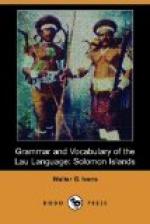The ordinary personal pronouns are used as possessive in cases where the pronoun can not be suffixed: afe nau my wife, arai nia her husband.
The instrumental prefix i occurs: kamu to eat areca nut, ikamu a line spatula.
5. Plural: To show plurality gi is used, following the noun na mwane gi the men. The word oro, many, may be attached: na mwane oro gi many men, tani ai oro many people.
The personal pronoun plural third gera is used to mark plurality: gera fiolo the hungry, gera priest da adea urina the priests acted thus.
Totally and completion are shown by sui finished or sui na: afutada sui they all, gera lea sui na they have gone already. To express totality the suffixed pronoun singular third and all persons plural are added to a root afuta, formed from afu to complete, with ta noun termination: afutanafera all the land, afutana nonigu all my whole body. It is a question whether the numeral qalu eight is used like walu in Sa’a of an indefinite number, e.g., qalu fera all lands; but te si nafera seems to be the proper usage.
6. Gender: There is no grammatical gender. The words mwane male, geni female, are added when the noun does not carry a sex distinction.
7. Nouns of relationship: With the exception of sasi brother, sister, nouns of relationship are never used with a suffixed pronoun: maa nau my father. The prefix mwai, denoting reciprocity of relationship, may precede: mwai asi nau brethren. In speaking of pairs of people ro is used: ro mwai sasina two brothers. The na of sasina, telana, etc., is a noun termination and is not the suffixed pronoun.
The articles ni for the singular and ote for the plural are used of women: ni aia a female relation, ote geni women.
The word for father is maa; the article na may be prefixed: na maa nau my father. The Rev. A. I. Hopkins says that maaka nau is also commonly used as meaning my father. The word for child is mwela, mwela na ai So-and-So’s son, mwela nia his child; aia is used for female relations with ni as singular article and ote as plural: mwaemwane sister, ni mwaemwane a man’s sister.
The adjective gale little, is used preceding the noun to describe something young: ro fe gale bola two young pigeons. The article used with te, mother, is ni: ni te nau my mother; ta ro mwai telana nau my wife and child, ta ro mwai fungona two relations-at-law; ai person, man, is used as a vocative: mwela ai hey, you there! na ai oe your people, ai ni raoa a servant, ai tou the little one, the lesser.




